Abstract
Agrobacterium radiobacter K84 is an effective, commercially applied, biological control agent for the plant disease crown gall, yet little is known about the survival and dissemination of K84. To trace K84 in the environment, spontaneous antibiotic-resistant mutants were used. Growth rates and phenotypes of streptomycin- or rifampin-resistant K84 were similar to those of the parental K84, except the rifampin-resistant mutant produced less agrocin 84 as determined by bioassay. K84 and a strain of Agrobacterium tumefaciens established populations averaging 10(5) CFU/g in the rhizosphere of cherry and persisted on roots for 2 years. K84 established rhizosphere populations between 10(4) and 10(6) CFU/g on cherry, ryegrass, and 11 other herbaceous plants. Populations of K84 declined substantially in fallow soil or water over a 16-week period. K84 was detected in the rhizosphere of ryegrass located up to 40 cm from an inoculum source, indicating lateral dissemination of K84 in soil. In gall tissue on cherry, K84 established populations of 10(5) CFU/g, about 10- to 100-fold less than that of the pathogen. These data demonstrate that K84 persists for up to 2 years in a field environment as a rhizosphere inhabitant or in association with crown gall tissue.
Full text
PDF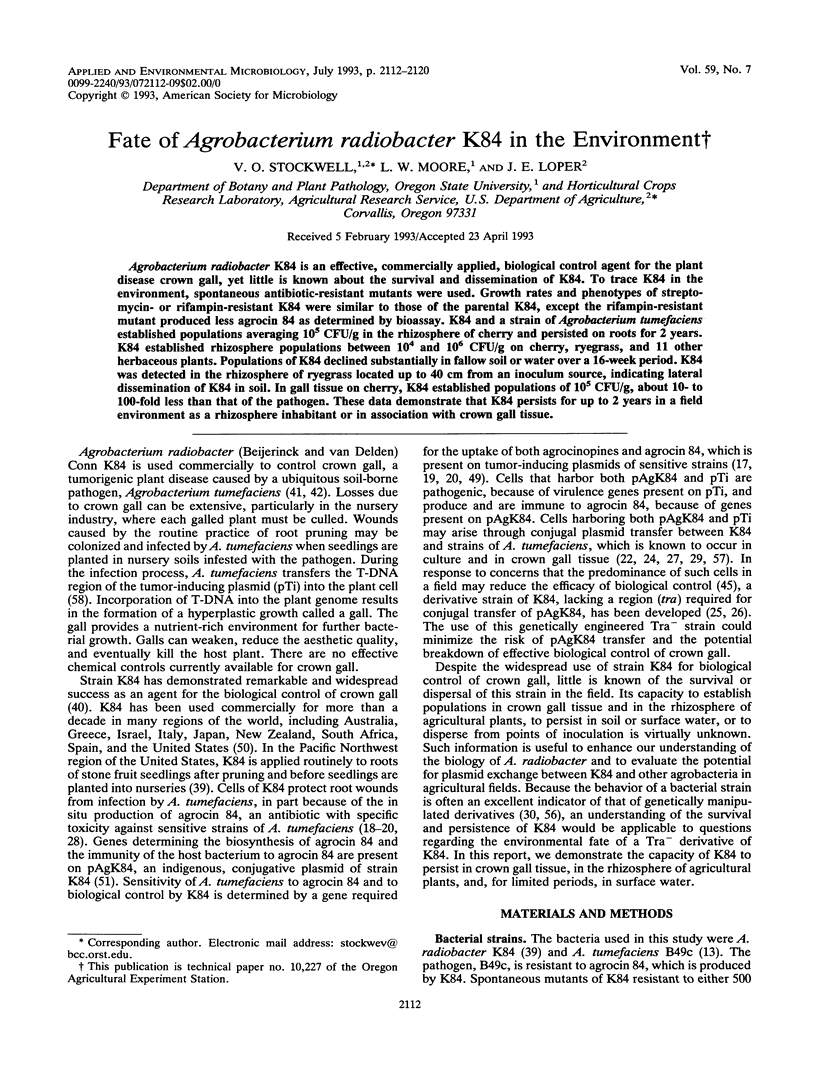
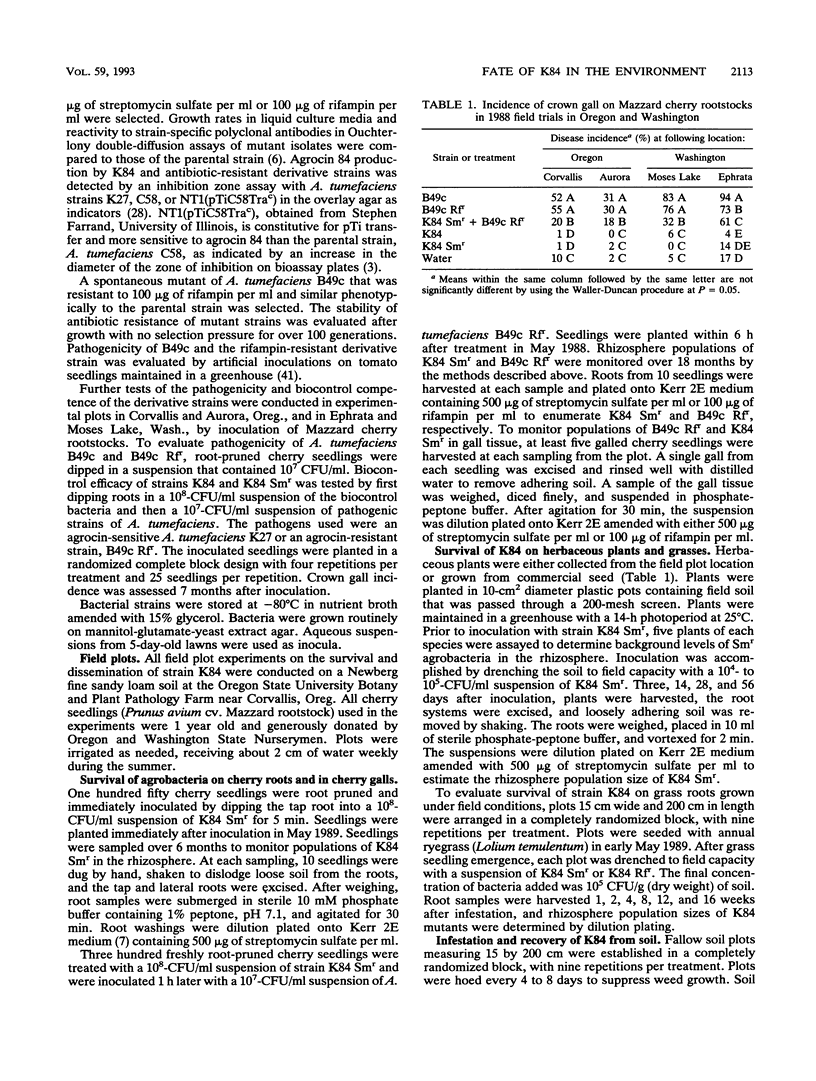
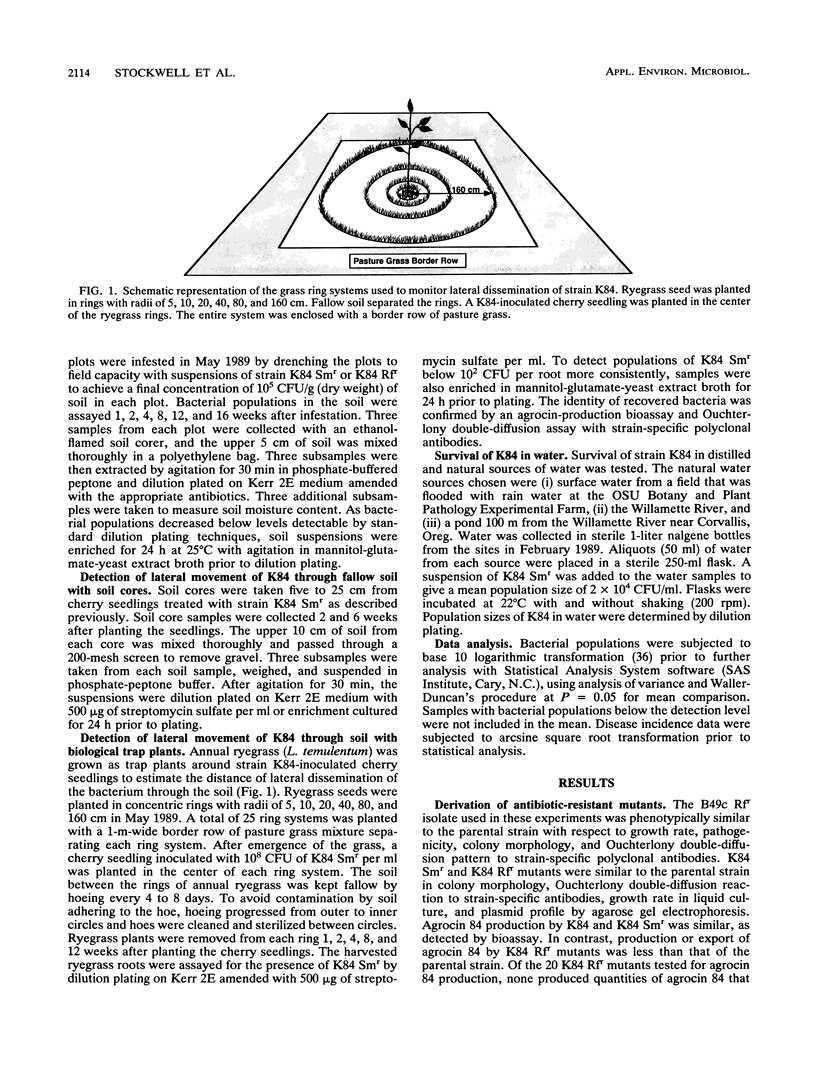
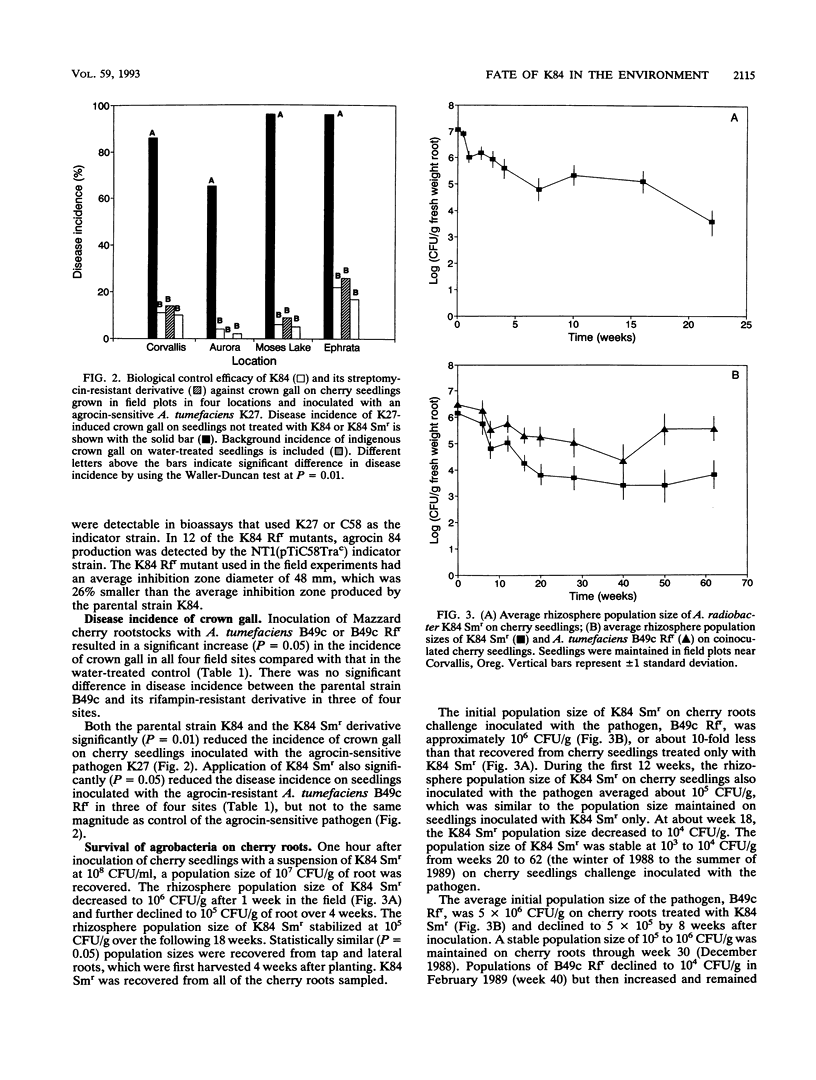

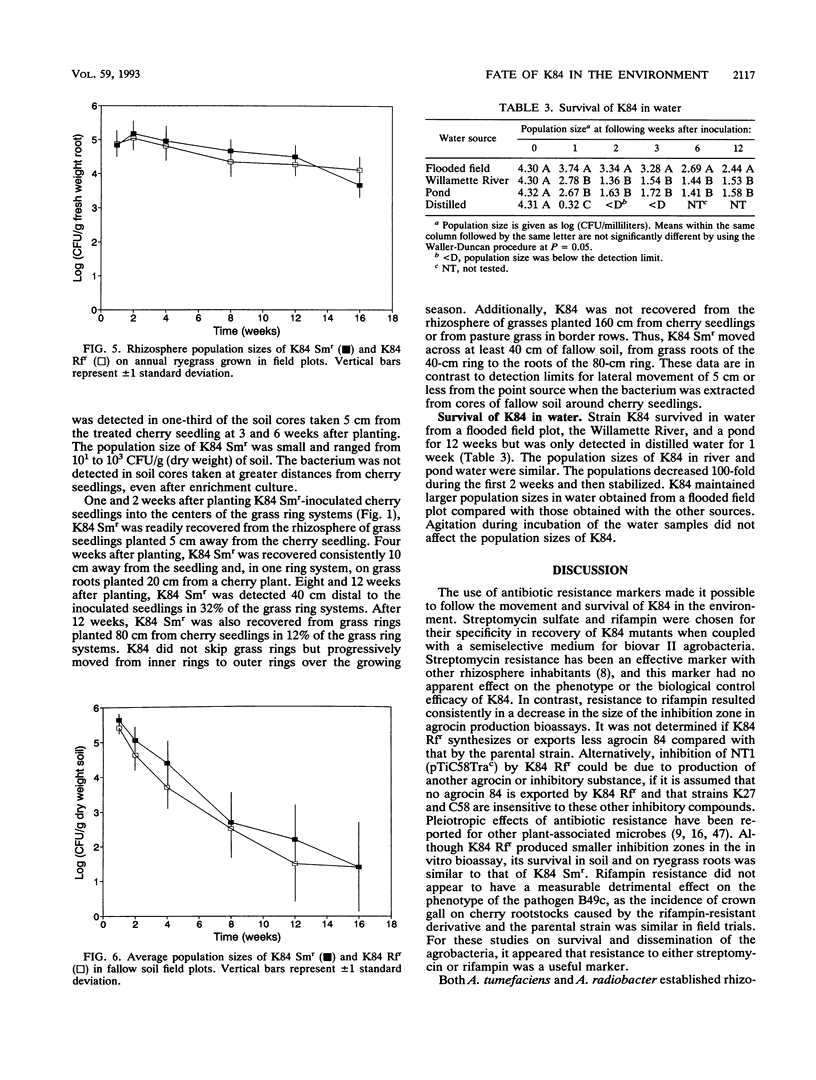
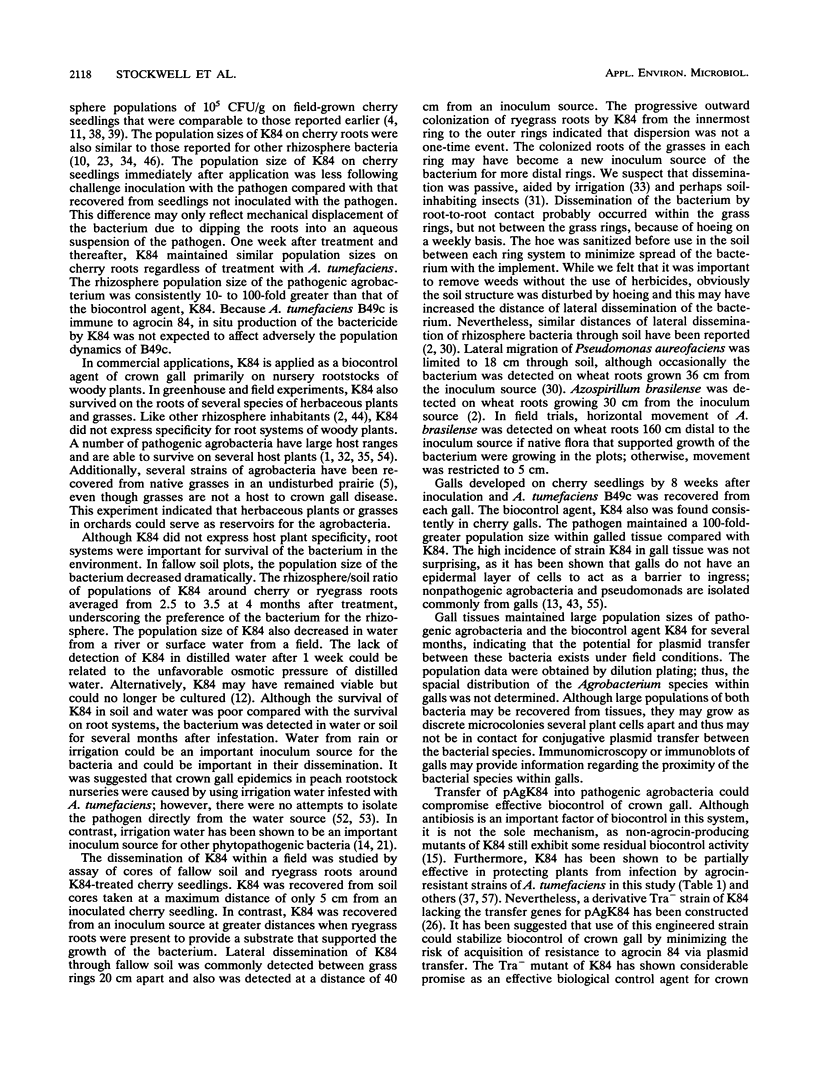
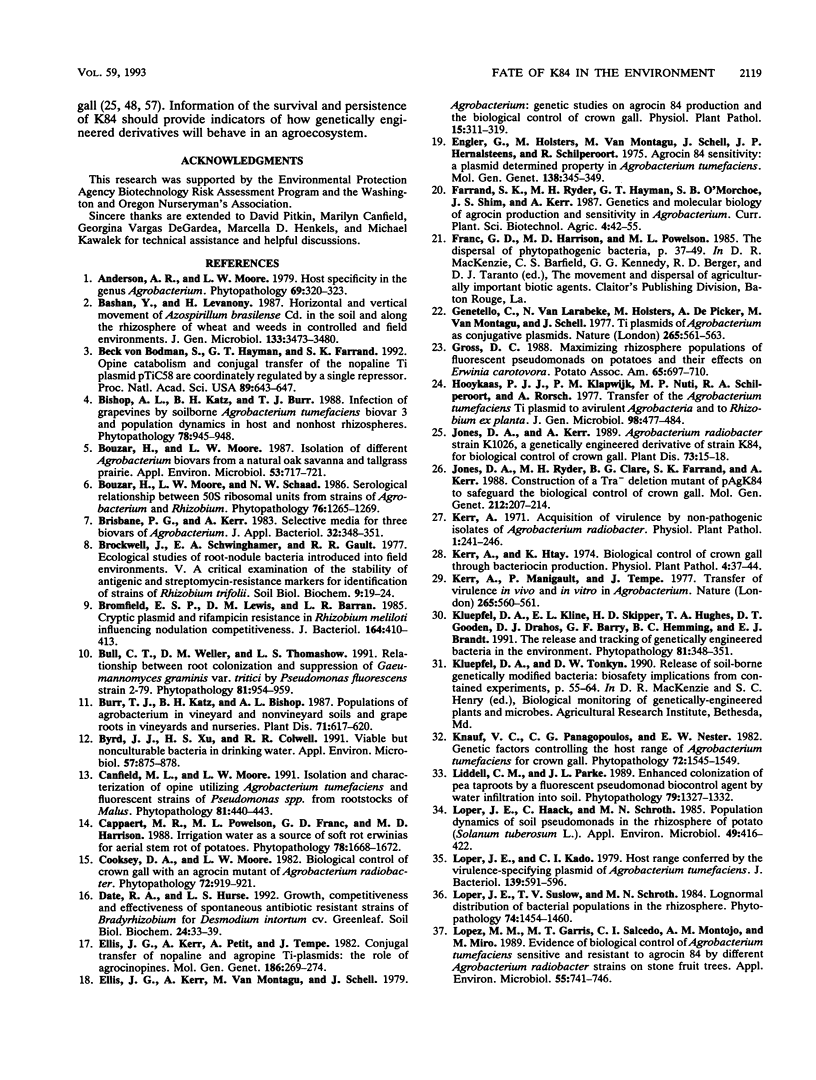
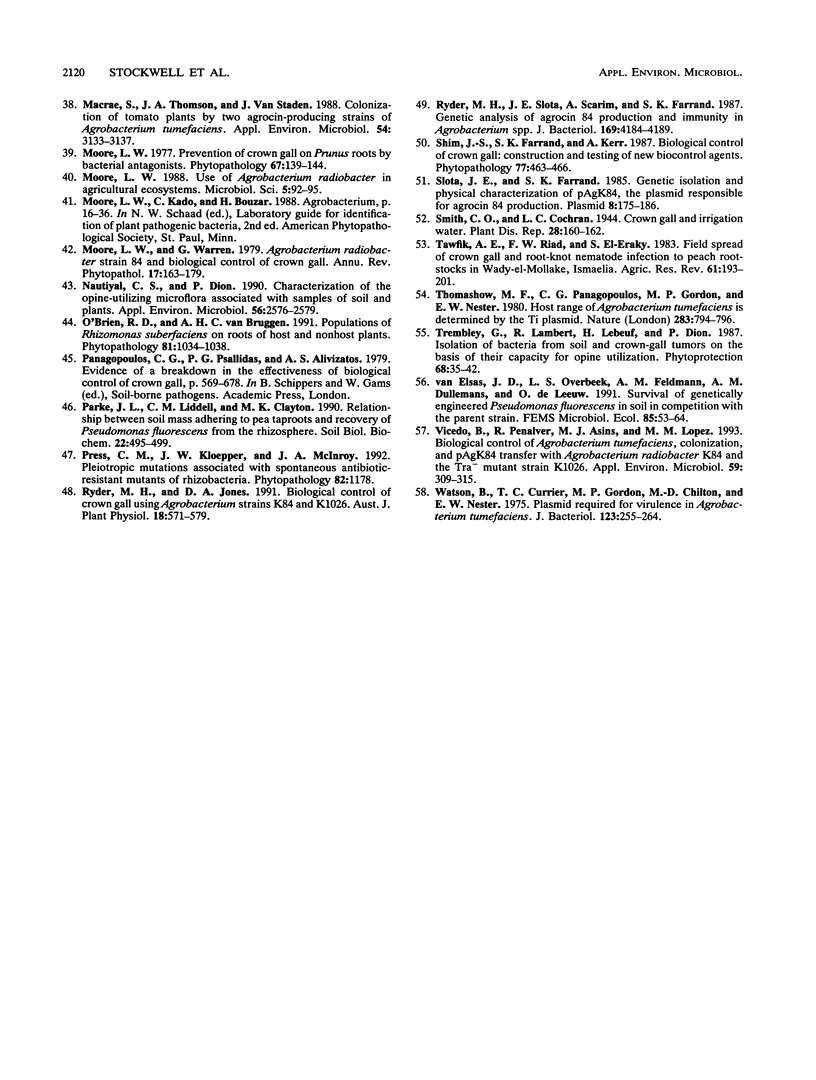
Selected References
These references are in PubMed. This may not be the complete list of references from this article.
- Beck von Bodman S., Hayman G. T., Farrand S. K. Opine catabolism and conjugal transfer of the nopaline Ti plasmid pTiC58 are coordinately regulated by a single repressor. Proc Natl Acad Sci U S A. 1992 Jan 15;89(2):643–647. doi: 10.1073/pnas.89.2.643. [DOI] [PMC free article] [PubMed] [Google Scholar]
- Bouzar H., Moore L. W. Isolation of different agrobacterium biovars from a natural oak savanna and tallgrass prairie. Appl Environ Microbiol. 1987 Apr;53(4):717–721. doi: 10.1128/aem.53.4.717-721.1987. [DOI] [PMC free article] [PubMed] [Google Scholar]
- Bromfield E. S., Lewis D. M., Barran L. R. Cryptic plasmid and rifampin resistance in Rhizobium meliloti influencing nodulation competitiveness. J Bacteriol. 1985 Oct;164(1):410–413. doi: 10.1128/jb.164.1.410-413.1985. [DOI] [PMC free article] [PubMed] [Google Scholar]
- Byrd J. J., Xu H. S., Colwell R. R. Viable but nonculturable bacteria in drinking water. Appl Environ Microbiol. 1991 Mar;57(3):875–878. doi: 10.1128/aem.57.3.875-878.1991. [DOI] [PMC free article] [PubMed] [Google Scholar]
- Engler G., Holsters M., Van Montagu M., Schell J., Hernalsteens J. P., Schilperoort Agrocin 84 sensitivity: a plasmid determined property in Agrobacterium tumefaciens. Mol Gen Genet. 1975 Jul 10;138(4):345–349. doi: 10.1007/BF00264804. [DOI] [PubMed] [Google Scholar]
- Genetello C., Van Larebeke N., Holsters M., De Picker A., Van Montagu M., Schell J. Ti plasmids of Agrobacterium as conjugative plasmids. Nature. 1977 Feb 10;265(5594):561–563. doi: 10.1038/265561a0. [DOI] [PubMed] [Google Scholar]
- Kerr A., Manigault P., Tempé J. Transfer of virulence in vivo and in vitro in Agrobacterium. Nature. 1977 Feb 10;265(5594):560–561. doi: 10.1038/265560a0. [DOI] [PubMed] [Google Scholar]
- Loper J. E., Haack C., Schroth M. N. Population Dynamics of Soil Pseudomonads in the Rhizosphere of Potato (Solanum tuberosum L.). Appl Environ Microbiol. 1985 Feb;49(2):416–422. doi: 10.1128/aem.49.2.416-422.1985. [DOI] [PMC free article] [PubMed] [Google Scholar]
- Loper J. E., Kado C. I. Host range conferred by the virulence-specifying plasmid of Agrobacterium tumefaciens. J Bacteriol. 1979 Aug;139(2):591–596. doi: 10.1128/jb.139.2.591-596.1979. [DOI] [PMC free article] [PubMed] [Google Scholar]
- López M. M., Gorris M. T., Salcedo C. I., Montojo A. M., Miró M. Evidence of Biological Control of Agrobacterium tumefaciens Strains Sensitive and Resistant to Agrocin 84 by Different Agrobacterium radiobacter Strains on Stone Fruit Trees. Appl Environ Microbiol. 1989 Mar;55(3):741–746. doi: 10.1128/aem.55.3.741-746.1989. [DOI] [PMC free article] [PubMed] [Google Scholar]
- Macrae S., Thomson J. A., Van Staden J. Colonization of Tomato Plants by Two Agrocin-Producing Strains of Agrobacterium tumefaciens. Appl Environ Microbiol. 1988 Dec;54(12):3133–3137. doi: 10.1128/aem.54.12.3133-3137.1988. [DOI] [PMC free article] [PubMed] [Google Scholar]
- Moore L. W. Use of Agrobacterium radiobacter in agricultural ecosystems. Microbiol Sci. 1988 Mar;5(3):92–95. [PubMed] [Google Scholar]
- Nautiyal C. S., Dion P. Characterization of the Opine-Utilizing Microflora Associated with Samples of Soil and Plants. Appl Environ Microbiol. 1990 Aug;56(8):2576–2579. doi: 10.1128/aem.56.8.2576-2579.1990. [DOI] [PMC free article] [PubMed] [Google Scholar]
- Ryder M. H., Slota J. E., Scarim A., Farrand S. K. Genetic analysis of agrocin 84 production and immunity in Agrobacterium spp. J Bacteriol. 1987 Sep;169(9):4184–4189. doi: 10.1128/jb.169.9.4184-4189.1987. [DOI] [PMC free article] [PubMed] [Google Scholar]
- Slota J. E., Farrand S. K. Genetic isolation and physical characterization of pAgK84, the plasmid responsible for agrocin 84 production. Plasmid. 1982 Sep;8(2):175–186. doi: 10.1016/0147-619x(82)90055-5. [DOI] [PubMed] [Google Scholar]
- Vicedo B., Peñalver R., Asins M. J., López M. M. Biological Control of Agrobacterium tumefaciens, Colonization, and pAgK84 Transfer with Agrobacterium radiobacter K84 and the Tra Mutant Strain K1026. Appl Environ Microbiol. 1993 Jan;59(1):309–315. doi: 10.1128/aem.59.1.309-315.1993. [DOI] [PMC free article] [PubMed] [Google Scholar]
- Watson B., Currier T. C., Gordon M. P., Chilton M. D., Nester E. W. Plasmid required for virulence of Agrobacterium tumefaciens. J Bacteriol. 1975 Jul;123(1):255–264. doi: 10.1128/jb.123.1.255-264.1975. [DOI] [PMC free article] [PubMed] [Google Scholar]


